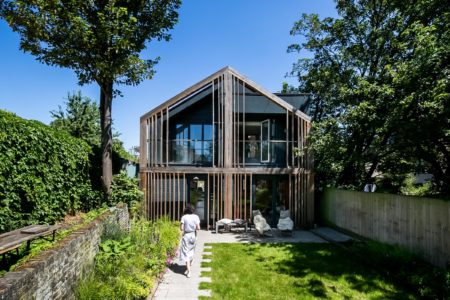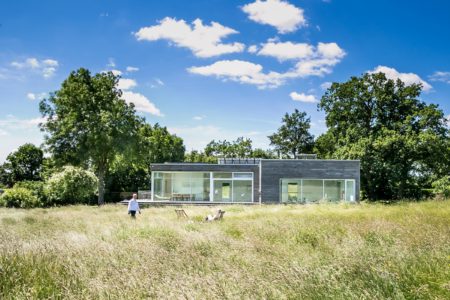Surman Weston’s light-led creation of a family home in south London

Words Nell Card
Photography Rachel Ferriman
This house on Cicely Road is the lockdown project of Tom Surman and Percy Weston, the founders of Surman Weston, an outfit recently recognised by The Architects’ Journal as one of the best young emerging practices in the UK today. The duo built the house on a triangle of grass that had no planning permission when they bought it, on the understanding that Percy would live here with his young family – partner Rhian Sutcliffe and three-year-old Ellis – until the pair agreed to sell. “When it’s your own project, the whole process of developing the design is virtually infinite – and this definitely wasn’t its first iteration,” admits Tom. “But we’re really happy with how it has worked out.”
The “heavy yet light, brutal yet crafted” home features generous fixed glazed panels that swallow up natural light. Accompanying narrow apertures – cleverly concealed behind hit-and-miss brickwork – provide natural ventilation without disrupting the clean lines of the exterior. A roof light crowning building highlights the tactility of the internal materials while luring you to the top floor. Here, behind a sliding cork hatch, is “the cherry on top”: an indoor-outdoor greenhouse-like glass room for all seasons.




Tom: “We bought this plot in 2018 at auction from Southwark Council. Percy and I have known each other for 18 years and we’ve worked together for 12 of them. In that whole time, it’s the most panicked I’ve ever seen him…”
Percy: “I was convinced we weren’t going to get it, so I just put my hand up at the auction. And then we won it and I thought: “Oh, shit…” It was the most risky thing we’ve ever done – putting money on a plot of land without planning permission. Plus, we hadn’t built something at this scale before, so it was a complete leap of faith. At the same time, we were really excited to be our own clients – and we’ve both always enjoyed making and being hands on. This was our opportunity to actually test that as a practice.”
Tom: “Externally, we have tried to reconcile the surrounding architecture. From the front of the house you can see the back of Peckham Levels – a fairly brutalist former multistorey car park with a concrete frame and hit-and-miss panels. There’s also a classic, more crafted Victorian terrace nearby and, directly next door, a terrace of utilitarian, almost detail-less homes built in the late ’70s.
“As a result, the form of this house is fairly monolithic, but the brickwork is very unusual. Referencing the Victorian terrace, we’ve used handmade York bricks in a Flemish bond. As you ascend the building, the header bricks are gradually set further and further back, which creates a patterned relief that helps dissolve the monolithic form. By the time you reach the roof terrace, greater gaps appear in the brickwork to form a hit-and-miss screen.


“Because it’s an end terrace, the house has windows on three sides, and each room has a large, fixed glazed pane and a narrow opening window concealed behind a hit-and-miss screen. Day or night, you can have the windows open and the house remains totally secure. The narrow windows are frosted, which softens the appearance of the brickwork and, as the sun tracks around the building, it casts lovely shadows on the internal walls. We’ve also incorporated a roof light down into the stairwell, which draws light into the centre of the plan, highlighting the textures in the entrance.”
Percy: “In the hallway and living spaces, recycled blockwork walls have been coated with a layer of lime slurry, which creates a soft, pillowy texture. It adds visual interest to the space, but it also expresses how the building was actually constructed. We were both interested in creating something that at first appears very simple but, the more you get into it, the more richness and detail you discover.”
Tom: “The whole house is only 106sqm and quite a lot of that space is given to the generous entranceway, which makes such a difference to day-to-day living. The space works really hard: there’s a loo under the stairs, a general store cupboard, a coat cabinet and a shoe step with storage incorporated into the foot of the staircase. Both Percy and I have lived on canal boats, so we appreciate how important storage is.”



Percy: “We wanted the house to feel voluminous, which is why we planned the generous floor-to-ceiling heights in the living spaces and kitchen. Part of the design process was about trying to remove the need for steel, so wherever possible we’ve used English larch sourced from a farm in Devon. We’ve had a lot of fun experimenting with craft. In the ceiling joists, for example, we’ve created scarf joints with screwless fixings. Again, the joists are exposed so the construction of the building is readable.”
Tom: “The end-grain wood block floor in the living room is made from the offcuts of those timbers. That kind of detail is the result of being here on site, seeing the amount of potential waste and being able to experiment.”
Percy: “The interiors are a hotchpotch of styles, which we’re absolutely fine with. I think it’s important a home is free to become an expression of the characters who live there. We’ve made some bespoke shelving that will remain with the house when we eventually sell, but there are also things like my granny’s chair, and art by friends and family, including my partner, Rhian, and my mum, who was a painter and ceramicist. She passed away 20 years ago and I inherited a lot of her work. Until now, I haven’t lived anywhere big enough to display it; it was emotional taking her pieces out of storage and finally being able to live with them.”
Tom: “We’ve introduced colour with the blue balustrade of the staircase, which was made by local fabricators. The heavily textured underside has been coated in lime, which we applied using a rendering machine called a Tyrolean flicker. The structure of the staircase becomes more delicate as you ascend towards the roof terrace, which is entered through the greenhouse via a sliding cork hatch.



“The greenhouse is a very versatile indoor-outdoor space. In the summer, the hatch can be left open to draw hot air up out of the house, drawing light down from above as it does. In the winter, the greenhouse acts like a winter garden. Even on cooler days, you can come up here for coffee in the morning or dinner in the evening; it’s a real haven in the city.”
Percy: “The surrounding terrace has generous planters and multi-stem silver birch trees. The plants have started to grow through the hit-and-miss panels and tumble down the façade of the building, which helps soften the brickwork. Ellis loves it up here: he uses the water butt to give the plants a drink – and digs up all the carefully planted bulbs…
“I come up here in the morning because that’s when the sun comes up over the trees beyond. It’s an incredibly spot that we’ve really enjoyed as a family. When the time comes to leave, I will definitely miss this space the most.”





















